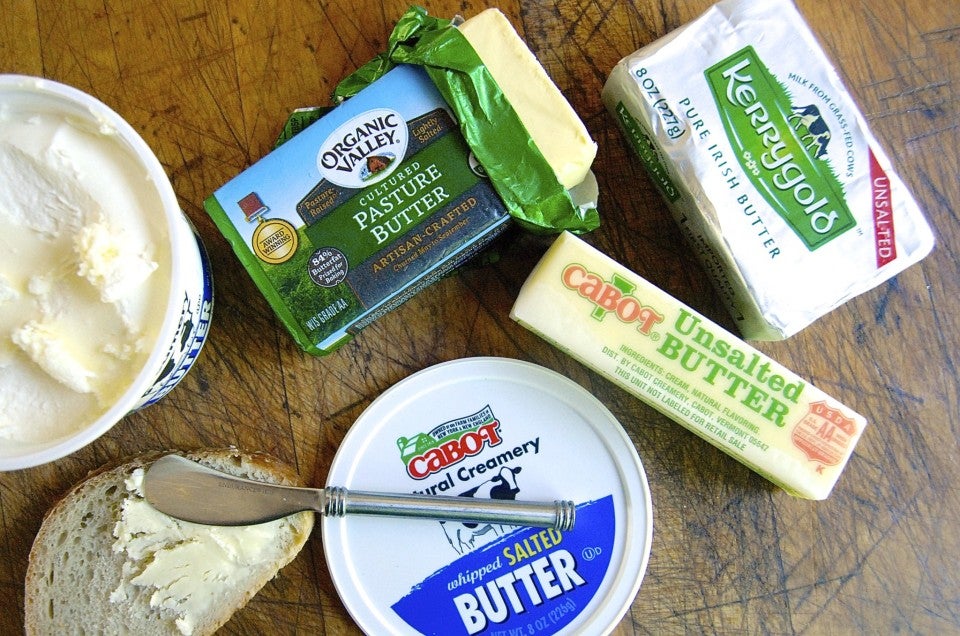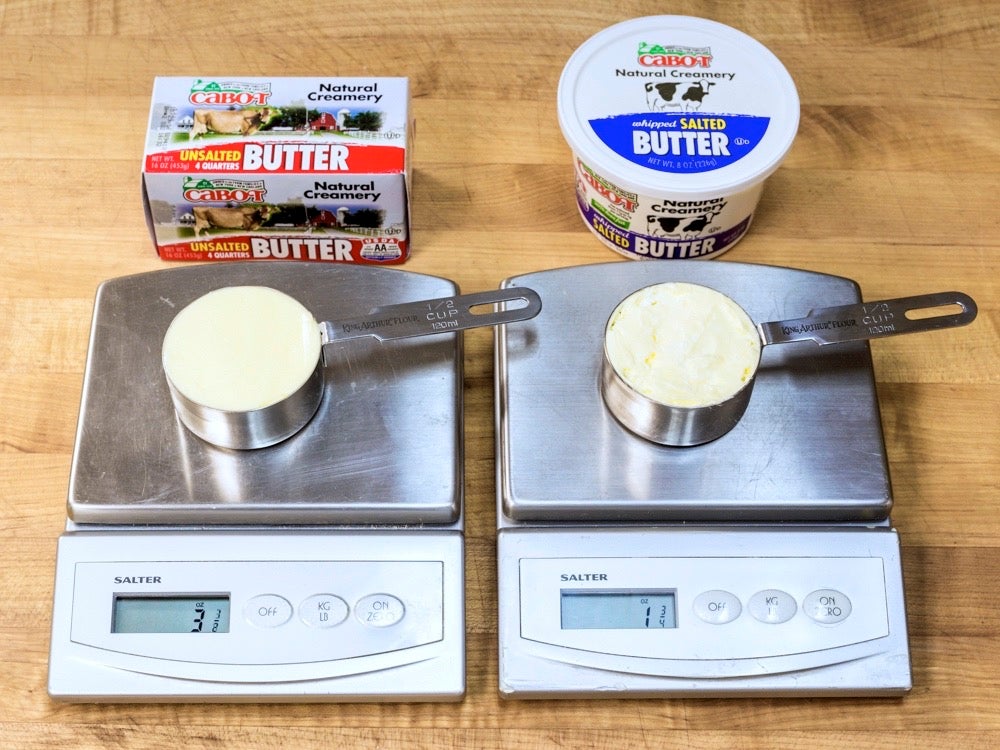


 Our magazine, Sift, is filled with stunning photography and delicious recipes. But it's also a great educational resource for bakers. From time to time, we pick out a reader's question from Sift to feature here in our blog — like this one from our Spring issue:
Our magazine, Sift, is filled with stunning photography and delicious recipes. But it's also a great educational resource for bakers. From time to time, we pick out a reader's question from Sift to feature here in our blog — like this one from our Spring issue:
Q: It seems to me the dairy aisle is getting more complicated by the day. When your recipes call for butter, what kind do you mean? European? Cultured? Whipped? Salted? Does it make any difference? – Cis Campbell, Denver, CO
In today’s world of ever-increasing choices, it’s easy to feel overwhelmed when choosing a seemingly simple ingredient like butter. The grocery store shelves are crowded with different brands and varieties, yet most recipes call for simply “butter.” Choosing butter for baking can quickly become a conundrum.
If you ask any of our test kitchen bakers, they’ll tell you that baking is all about specificity: how much and what kind of ingredients you use determine the texture, flavor, and appearance of your baked goods. So what do we mean, exactly, when our recipes call for “butter"?
That means it’s 18% water, at least 80% butterfat, and 1% to 2% milk solids.
Why grade AA? It's the most buttery in flavor of all three grades: AA, A, and B. It has a light, fresh flavor and smooth texture — a perfect butter for baking and using at the table.
Our recipes are developed using this type of butter, so if you’d like to replicate the same delicious results at home, we recommend using grade AA unsalted butter, too.
We use 1-pound blocks of Cabot butter in the test kitchen, but you can use whatever brand your local grocery store stocks. There's a myriad of butter possibilities that await in the supermarket.
Take a peek at the labels next time you’re browsing the dairy aisle. You might be surprised at all the tempting varieties you come across when trying to choose the best butter for baking.
European-style butters have less water and are higher in fat, ranging from 82% to 86% butterfat. If used in a recipe not calling for it specifically, European-style butter can create a greasy, sometimes drier result than grade AA butter.
We decided to bake up two batches of our shortbread recipe using grade AA and a European-style butter to see if there was any difference in how “leaky” they were.
Both shortbreads were left to sit on craft paper for two hours after coming out of the oven. The size of the grease stains says it all — the higher fat content of the European-style butter caused a greasier, sandier texture in the end.
Don’t write off European-style butter just yet, though. Some pastry chefs swear by it for making croissants. They think it makes their laminated dough more workable at colder temperatures, and also makes a richer pastry.
But there are also those who argue that just a little bit more water in butter can be a good thing. Water turns into steam in the oven, which helps create lovely layers in croissants, and a flaky texture in scones and biscuits.
We wondered if the water content would create a visible difference in the texture of scones. To find out, we baked our scones two ways, one version with European-style butter and one with grade AA.
The European-style scone had more of a cakey texture, while the grade AA scone had that classic craggy, layered look. It also rose nicely, where the European-style scone looked slightly sad and slumped.
If you ask me, I’d say save the European-style butter for spreading on a slice of chewy baguette at the table to really experience its velvety consistency.
Or if you’re determined to bake with this luxurious ingredient, try using slightly less of it (start with 3/4 of the amount called for), and chilling your dough before baking.
Next up is whipped butter, another kind that’s more suited to being used at the table rather than in your baking.
Whipped butter is designed to be more spreadable, so it’s aerated with a special type of gas. It also contains additives like stabilizers or vegetable oil to keep it from oxidizing or going bad.
These qualities make it tricky to bake with, because 1/2 cup of whipped butter weighs notably less than a 1/2 cup of grade AA butter.

You’d need to use about 2X as much whipped butter to equal the amount of grade AA butter, and there’s no guarantee that the texture or flavor would be the same. So best to save whipped butter for spreading on your toast and biscuits.
Speaking of flavor, cultured butter is my favorite when it comes to taste. It’s slightly tangier than traditional butter and has a super creamy mouth-feel. Sounds romantic, right?
Well, here’s the science: Cultured butter is inoculated with live bacteria that release lactic acid, creating its zippy taste.
There are many companies that make cultured butter — Organic Valley and Vermont Creamery are often found in my fridge. (Vermont Creamery even sells its cultured butter in a cute little basket, adding to the appeal!)
Although cultured butter is undoubtedly delicious, it’s not the best butter for baking. Instead, slather it onto warm baked goods as they come out of the oven. You’ll be thanking the bacteria for all the delicious work they do!
My love for salt dominates almost all other flavor cravings at times. But when choosing butter for baking, I always use unsalted, and we recommend you do, too.
Salt acts as a preservative and masks any potentially funky flavors, so salted butter often sits on grocery store shelves longer than unsalted does. To ensure you're using fresh butter, choose unsalted.
Another plus: you're able to control the amount of salt in your baked goods when you bake with unsalted butter. You determine the ultimate flavor. Using unsalted butter is a win-win.
Hint: If you’re like me and love a salty kick in your sweet treats, increase the salt just a bit by heaping your measuring spoons rather than leveling them off.
But if you find yourself stranded in a kitchen with only salted butter, it’ll work in a pinch. Most brands add about 1/4 teaspoon salt per 1/2 cup stick, so adjust your recipe accordingly.
Let’s return to Cis in Colorado and the initial butter quandary. Does the kind of butter make any difference in baking?
A: It definitely makes a difference! All butter is not created equal when it comes to baking.
As we like to say in my family, “There are no bad options.” Butter is one of the creamiest, most delicious ingredients out there, and by using butter in baking you’re already on the right track.
You’ll likely experience differences in the flavor and texture of your baked goods if you use something other than grade AA unsalted butter, but you’re welcome to do a bit of experimenting until you find your favorite butter for baking.
Now some of you might already be thinking beyond butter — what about margarine? Or shortening? Check out our blog post on Cookie chemistry to see what effect these ingredients can have on your baked goods. (There's even a part two for those of you that really want to delve into the subject.)
What about using coconut oil? Or even vegan butter? We’ve got you covered there, too. Check out my fellow blogger Alyssa’s post, Substituting fats in gluten-free baking. Even if you’re a gluten lover, you can learn something.
Let’s do something with all this butter knowledge and bake! What are your favorite buttery recipes to bake? Please share them in the comments below.
Thanks to photographer Nic Doak for taking the pictures in this butter-filled blog; and to Sift editor Susan Reid for talking butter with me as often as I asked.